Art World
How the High-Impact Work of Matthew Barney Influenced 6 Artists
The artists Tony Lewis, Jacolby Satterwhite, Ana Prvacki, Kevin Beasley, Sable Elyse Smith, and MPA weigh in on Matthew Barney's maximalist vision, from "Cremaster" and "Drawing Restraint", to the currently on view "Secondary."

Call it the “Summer of Matthew Barney.” In recent months, the New York artist has had five solo shows in four different cities, spanning Regen Projects in Los Angeles, Gladstone Gallery in New York, Sadie Coles HQ in London, and Max Hetzler and Fondation Cartier in Paris. Their common focus is Secondary, a multidisciplinary project in which a 1978 NFL collision becomes an allegorical structure for the male body and the fragility of aging bones. And in typical Barney fashion, it’s a story without words, told through operatic cinema, installation, and the transformation of materials, plus new forays into choreography.
“Secondary” is on view at Regen Projects and Sadie Coles HQ until August 17 and at the Fondation Cartier until September 8.
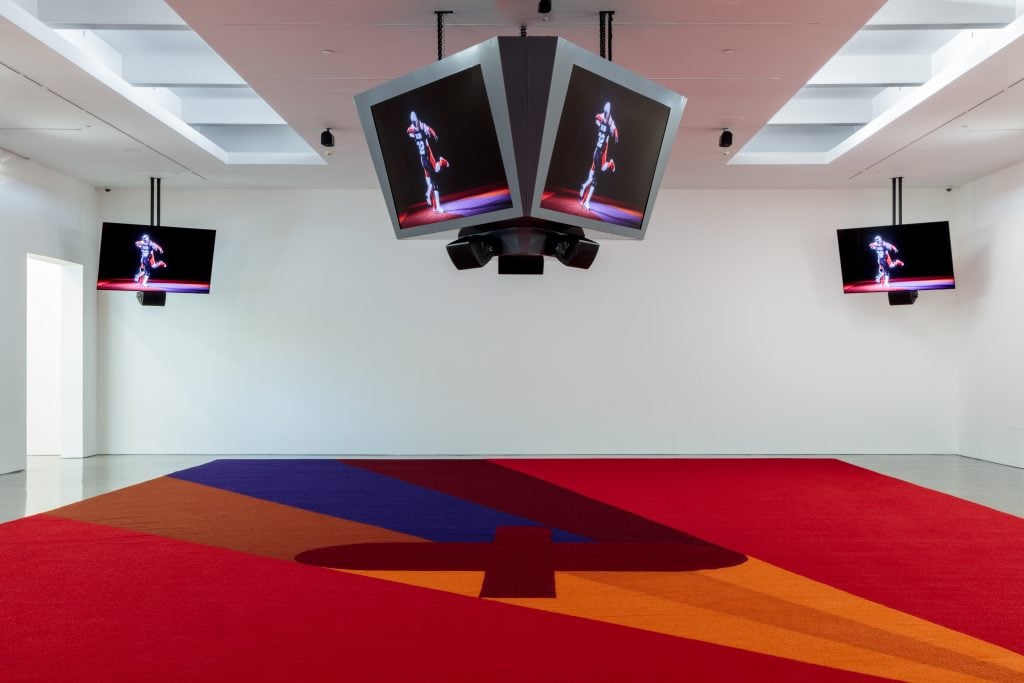
Installation view of Matthew Barney SECONDARY: commencement at Regen Projects, Los Angeles. Photo: Joshua White, Courtesy Regen Projects
On the occasion of Barney’s world tour, we’re running a playback of his career highlights, deferring to the commentary of artists as the best critics and stewards of art history: Tony Lewis, Jacolby Satterwhite, Ana Prvacki, Kevin Beasley, Sable Elyse Smith, and MPA. As experts in drawing, performance, sculpture, installation and video, they examine the importance of early projects like Drawing Restraint (1987-ongoing), a hybrid body of work adding physical obstacles to the process of mark-making, and his groundbreaking Cremaster Cycle (1994-2002), a series of five wildly visual films loosely based on the descent of the testes. They consider the status of Barney’s identity-based practice, as well as the impact his work has had on their own.
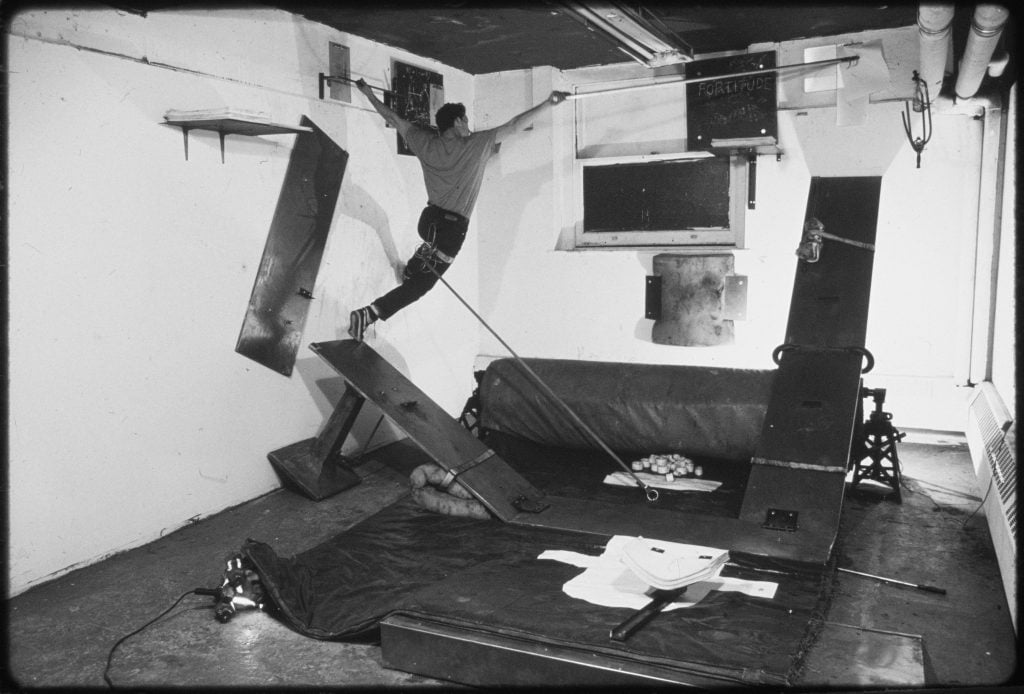
Matthew Barney, DRAWING RESTRAINT 2, 1988. Jointly owned by Laurenz Foundation, Schaulager, Basel; and The Museum of Modern Art, New York, Richard S. Zeisler Bequest and The Blanchette Hooker Rockefeller Fund (both by exchange) © Matthew Barney. Production Still: Michael Rees, Courtesy of the artist and Gladstone Gallery
Let’s start at the beginning. Can you tell me about your first encounter with Matthew Barney’s work?
Tony Lewis: I saw one of his very first Drawing Restraint pieces in a book in grad school, around 2009. The drawings were shit, but the process was very intriguing: He was just strapping shit to his body and jumping off of things, trying to make a mark on the ceiling. That struck a chord. In art history, we talk about drawing as a support for painting, akin to a sketch, but that project had everything to do with the process and the labor, mixing drawing with a bit of sculpture and performance. That made me feel the same way I felt looking at Richard Serra’s and Sol Lewitt’s drawings; they helped me build my own conceptual language and material sensibility beyond just pencil and paper.
Ana Prvacki: In the early ’90s, when I saw his Hugo Boss exhibition in New York, I remember entering the room and having the sense of this complete aesthetic experience, from the lighting to the colors to the fact that he was making his own frames. He was talking about sensuality and desire in a way that ’90s fashion was leading but contemporary art was lacking. It felt really powerful. The work had so much pleasure.
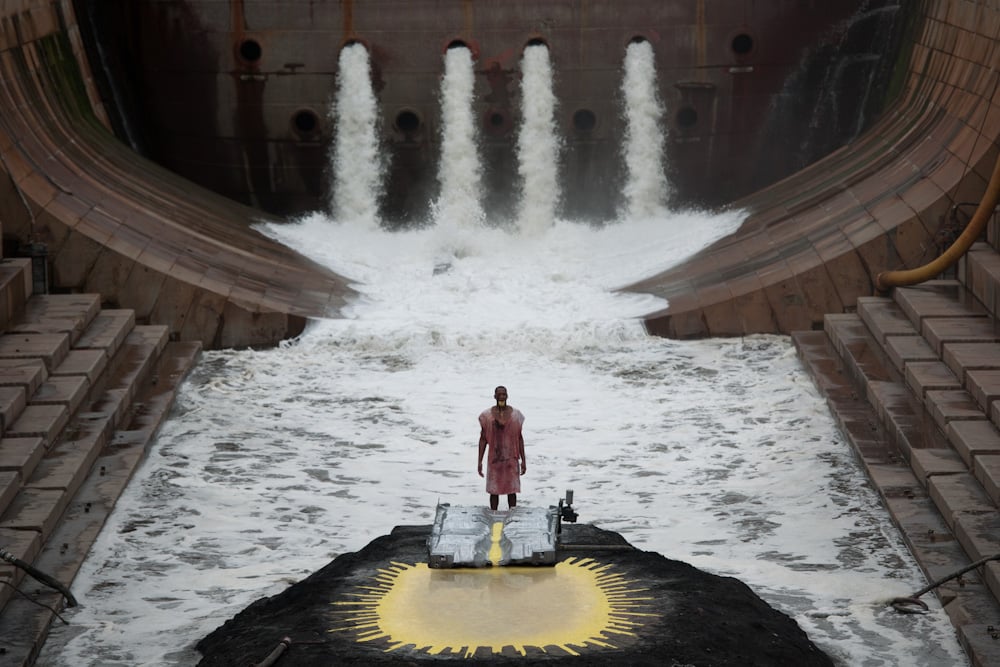
Matthew Barney and Jonathan Bepler, River of Fundament (2014) production still. Photo: Hugo Glendinning. © Matthew Barney, courtesy of the artist and Gladstone Gallery.
Kevin Beasley: I had the opportunity to work with Matthew on River of Fundament in Detroit around 2009. It definitely wasn’t the first time seeing his work, but it was pretty remarkable to see his process-oriented focus translate from the studio onto the screen and then into larger exhibitions. I saw the film as an interrogation of the American industrial landscape, but with Egyptian aesthetic tropes and metalworkers pouring iron into a car that drives off the side of a bridge. His depth in conceptualizing a sequence of events in dialogue with his subject matter and materiality is extremely complex—even at times when I can’t quite follow or don’t fucking know what’s going on.
Sable Elyse Smith: I saw the Cremaster cycle films when I was in grad school at Parsons, probably around 2011. At the time I knew I was interested in narrative storytelling and time-based media, but not anything that fit into the formats or genres I was taught. It offered a concrete example of what I wanted to articulate: a series of incredibly striking images that move sequentially, but aren’t bound by a narrative cause and effect. That boundarylessness was exciting to me, and it was so visually lush. At the end it leaves you with this ghost image, this feeling that doesn’t have to be rational.
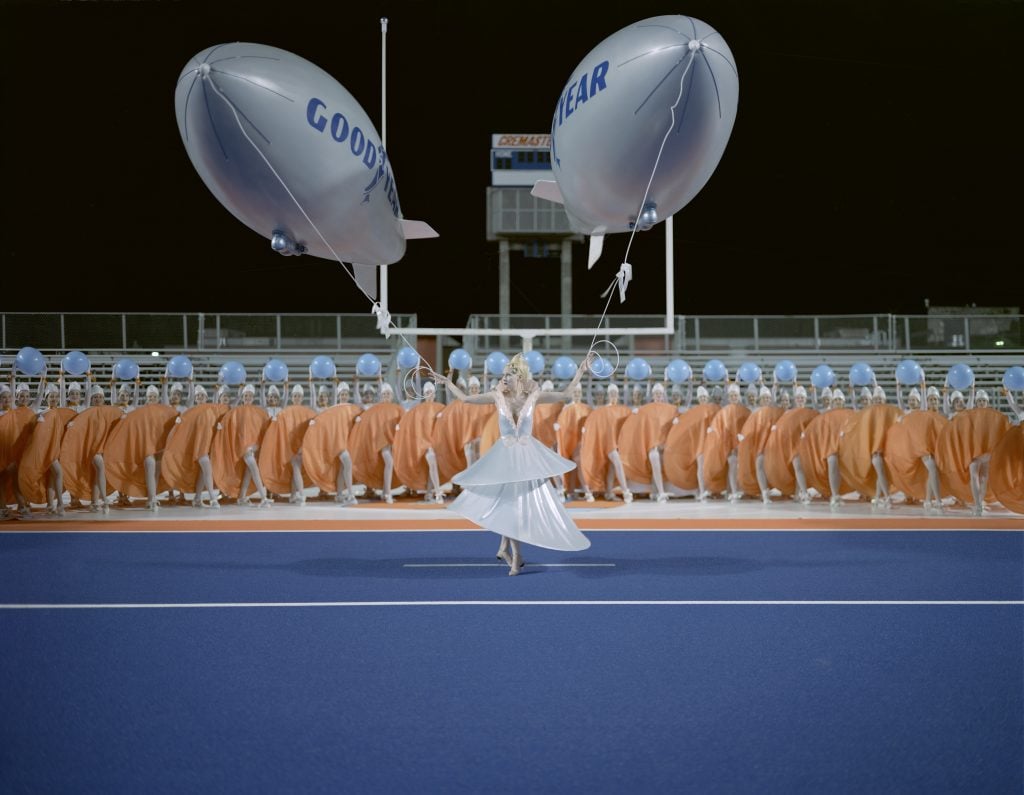
Matthew Barney, CREMASTER 1 (1995) Production still ©1995 Matthew Barney Photo: Michael James O’Brien Courtesy Regen Projects, Los Angeles, and Seoul
Jacolby Satterwhite: I saw the Cremaster cycle my senior year of high school, around 2004, and I loved it. He was bridging these incongruent dialogues that made sense to him, merging a male biological process with the process of art-making, and triangulating that with pop culture, masculinity, metal, football, rock climbing, and kabuki theater. He was like the ’90s cinematic version of Joseph Beuys and Bruce Nauman. He used his camera to create a certain Zeitgeist in pop culture and cinema that paved the way for younger artists to really go crazy with.
I love how whenever artists talk about Barney’s 2003 Cremaster Cycle show at the Guggenheim, they describe it as a meteor that struck the New York art world.
MPA: The Guggenheim show made my jaw drop. I couldn’t afford the Cremaster book at the time, and every display copy in New York City was always worn out. It just stunned me to see performativity that wasn’t a reference to 1960s endurance performances. We were coming out of the relational aesthetics of the’ 90s, and he was bringing performance art to film as something visual: it was grunge kids and synchronized dance with crazy headdresses and powder-pink latex. He was like a cinematic Renaissance painter, reclaiming myth and magic in the West. I hate to admit it, but I remember walking through that show and understanding that this was the kind of artist I’d be.
Satterwhite: Coming out of the conceptual era of the ’90s, my teachers didn’t like the financing and budget around it; they were grasping on to an archaic purity that he was yanking out of the stratosphere. But my generation was ready for the phase of postmodernism Barney was offering, especially with the Internet. He was a precursor to the meta-narrative multiverse you see in movies like Everything, Everywhere, All at Once: constant crossovers, costume references, and stories inside stories. I understood it, and I was convinced the whole way.
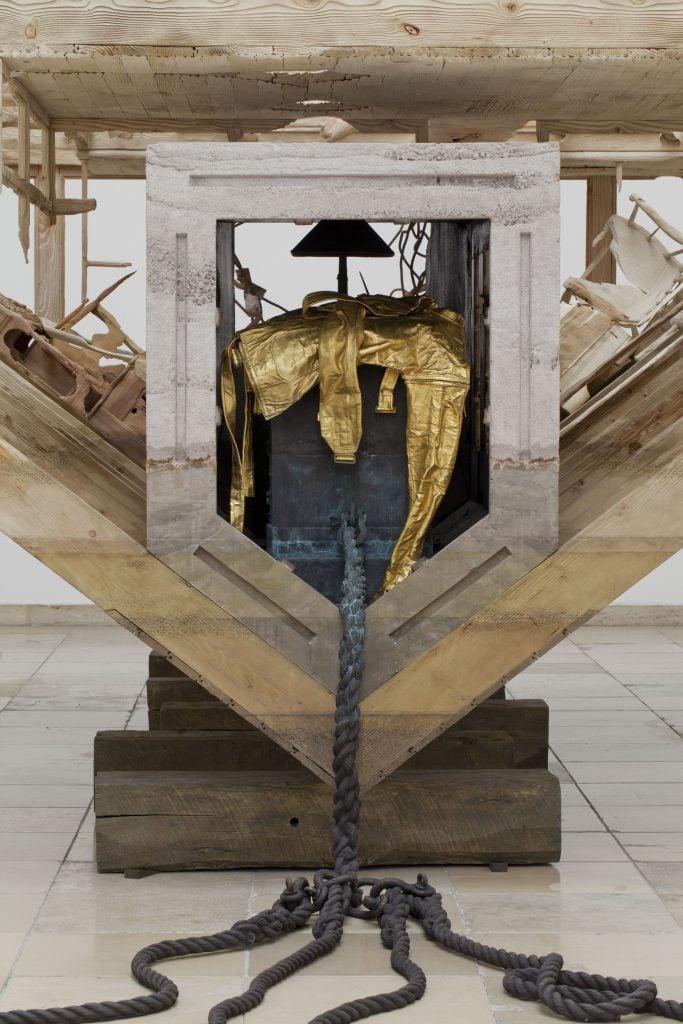
Matthew Barney, Boat of Ra, 2014 © Matthew Barney. Installation photography by Haus der Kunst, © Maximilian Geuter Courtesy of the artist and Gladstone Gallery.
The world-building you’re describing is extraordinary. Barney’s overall practice is sublimating a lived experience into a million different materials or mythologies. There’s a meticulous attention to detail on a massive scale, and his ideas retain this physical potency even as they move across different mediums.
Kevin Beasley: In his focus on process, sculptures are made and undone throughout all of his films, and as they operate in multiple spaces, they’re able to offer different things. To see Secondary in Matthew’s studio, where he thinks and works through the materials, is very different from seeing it at Regen Projects, where it’s more cinematic and buttoned up. His comfort zone is to constantly shift the perspective on his processes, and the audience shifts with him.
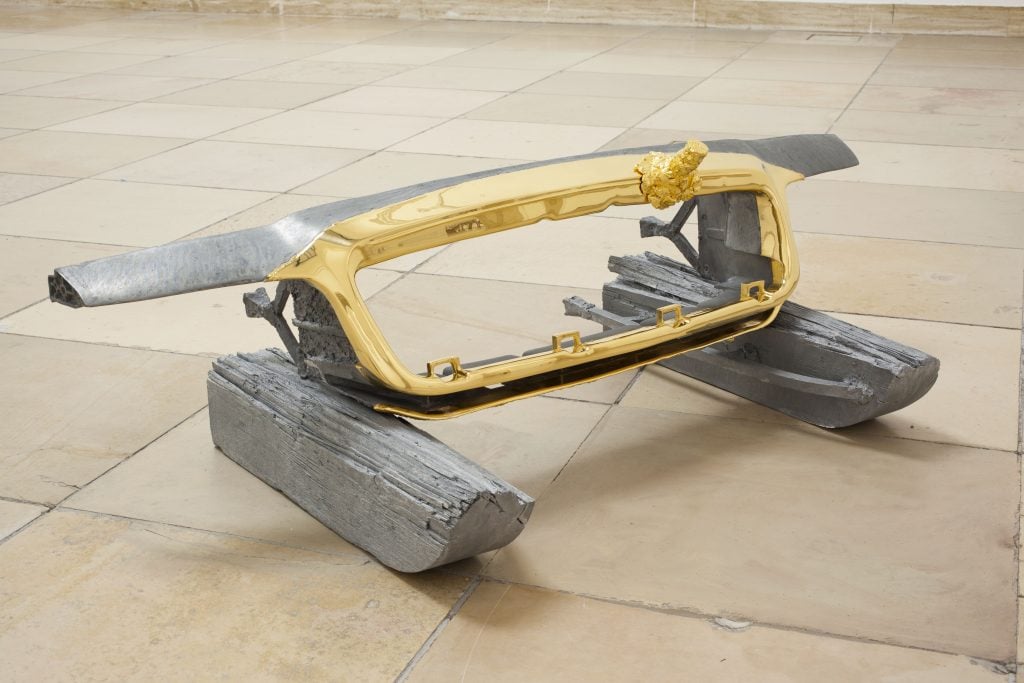
Matthew Barney, Crown Zinc, (2013) © Matthew Barney Installation photography by Haus der Kunst, © Maximilian Geuter Courtesy of the artist and Gladstone Gallery
Smith: I haven’t seen the video for Secondary, but I did see the sculptures at Barbara Gladstone. The dissection of football and violence in American entertainment was an interesting concept, but it was the form and material dexterity that was really innovative to me. What seems consistent throughout his practice is how his materials translate a sort of visceral, bodily affect—this potency that makes static objects feel alive.
MPA: I think is a key difference from the glib, clinical installation of so much visual art. If you’re not going to be there as a live body, Barney asks how to animate the site as if you were watching a performance. When River of Fundament came to MOCA, he marked up the walls of the museum in a way that made you feel life had been there. It was a form of institutional critique that still felt artistic—an approach that was not intellectual, but visually intelligent.
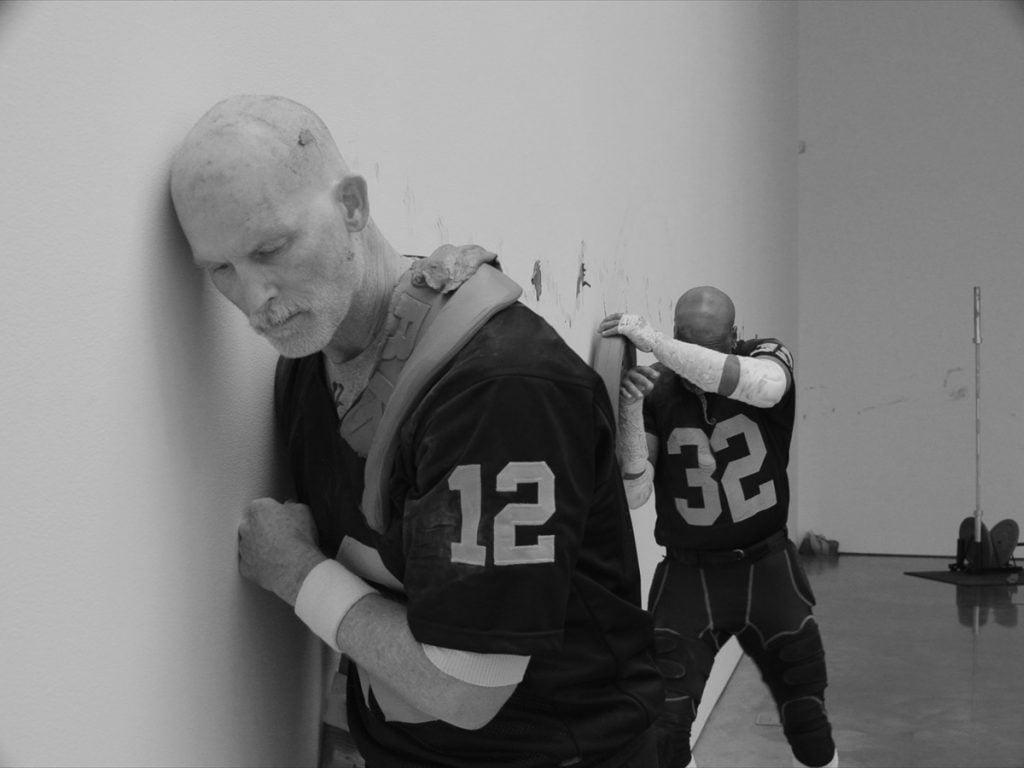
Matthew Barney, DRAWING RESTRAINT 27 (still). ©2024 Matthew Barney. Courtesy of the artist and Gladstone Gallery.
It surprises me how divisive Barney’s practice is. Lately artists have been telling me how his explicit references to American football amount to bro art, and in 2003, Roberta Smith panned his Guggenheim show as “implicitly oppressive.” Do you feel those things as a viewer?
MPA: Barney is an artist who’s taken up enough space to anticipate an eye roll, and anyone ostensibly on the margins is not seeking comparison to a white man. But as he was walking through sewage in the bowels of Detroit in River of Fundament, I did feel like he was critiquing masculinity, rejoining what a lot of us already knew. It’s just that something about being a white male conditioned him with the confidence to never have to explain himself, almost like he could proceed quicker to the vision. I mean, he used the Guggenheim as a set for the Cremaster cycle—has anyone ever told him no?
Beasley: It’s true: he was a model who went to an Ivy League school who’s very much into athletics. He’s not one to shy away from that white male aesthetic, but I don’t know if he’s reaffirming it, because he’s constantly breaking it down. Matthew’s been dressing in drag since the ’90s and exposing his his body in ways that are actually quite vulnerable. I feel like it’s a bit dismissive to not consider that complexity.
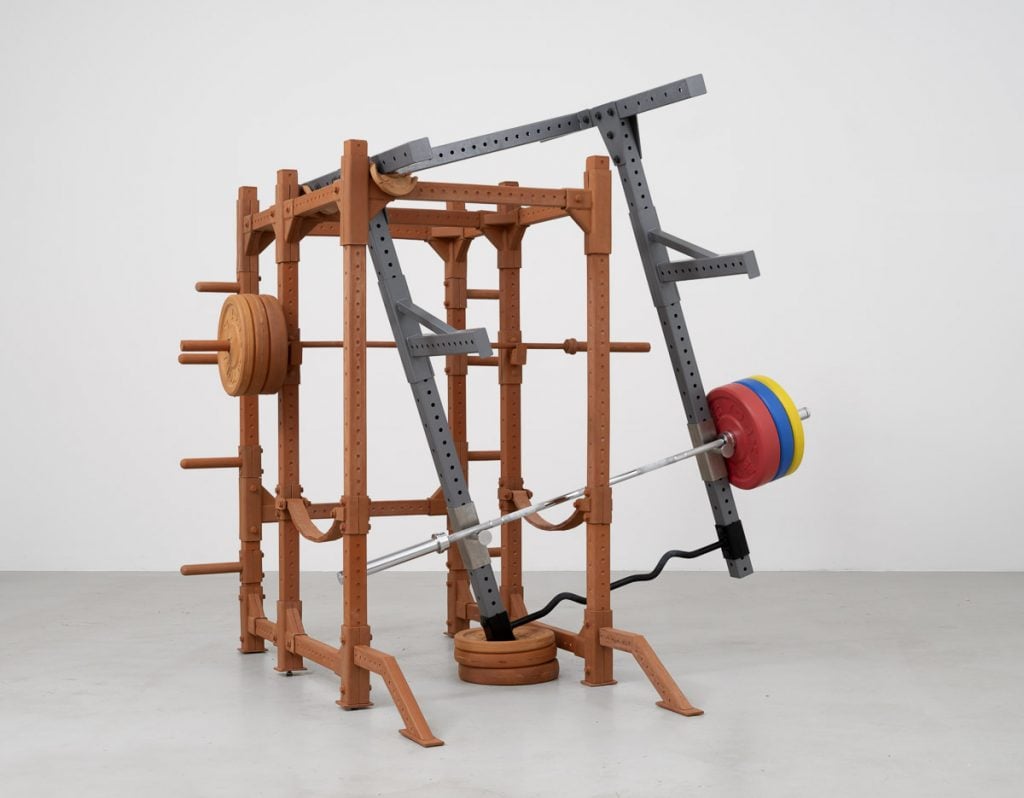
Matthew Barney, Power Rack / Iron Inversion (2024). Courtesy of Gladstone Gallery.
Lewis: The second his work shifts away from drawing into high-production, fantasy-driven narratives, it starts to feel like a masturbatory white male experience—which is fine! That serves the artist’s mindset and desires. I just think the dopest thing is making the drawings.
Conversely, even his haters have cited his frequent references to the anus—from inserting things into his actual rectum to taking labored journeys through cavities that are ultimately flushed—as elements of queerness. Would you say so?
Satterwhite: I would call that humiliation or embarrassment. His willingness to operate in those modes of transgression scratches the surface of really interesting conversations—like the era of the loser aesthetic, when artists in their mid-30s like Sean Landers and Tracey Emin were making work about failure, vulnerability, and obsession. I definitely think Barney has something to do that. That’s the pendulum of his self-aggrandizing, monumental, billion dollar practice swinging the other direction.
Thinking in the context of your own work, do you see ways that Matthew Barney impacted your trajectory or your practice? Or what doors did he open and lead you to explore?
Satterwhite: He had a major impact on me. I was educated as a painter, but when I began leaning into the thousands of schematic diagrams my mentally ill late mother Patricia Satterwhite left behind, I realized I had a more conceptually rigorous, self-mythologizing, world-building practice. The way Barney emblemized the global culture that shaped his masculinity gave me the permission to turn my complex and unique niche personal history into a mythological codex. It gave me the freedom of authentic artistic expression; to make any kind of work that I could possibly ever want to make.
Prvacki: We have very different practices, but looking at the Cremaster Cycle’s resistance to logic, it was empowering to see that that as an artist, you could build your own world based on imagination and desire that you don’t have to explain.

Matthew Barney and Jonathan Bepler, River of Fundament (2014) production still. Photo: Hugo Glendinning. © Matthew Barney, courtesy of the artist and Gladstone Gallery.
Sable: I wouldn’t say he changed the trajectory of my career, but was more of an affirmation at an early point in my early art education. He exploded the genres of longform filmmaking in a way showed me the possibilities of art-making, and a world where these contemporary ways of working can exist.
Lewis: Going back to the subject of football, Drawing Restraint might have been the first time I’ve seen art distinctly related to an athletic sort of mindset: the struggle, the labor, the sweat, the space; the competition; the process of becoming. I felt a level of justification in this natural kind of tendency in my work, where sports were a big part of my life. I frequently refer to my studio as an athletic space, where my drawings are big, physical things.
Beasley: He’s a sculptor, and I feel really connected in that way, but his medium is wide open. He’s created an entire world around the process of making things that aren’t just objects—they’re extensions of the body and mind.
MPA: For me, he really held the spectrum of performance art. When so many cerebral forms were drowning out aesthetics with essays and proofs, he was using poetry; he was anointing himself as a weirdo and embracing the beauty in the grotesque. Also, while so much performance art can be bad due to lack of means, he set a new bar in terms of budget that allowed me to say I want that production value for art.





